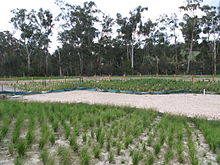Restoration ecology
Appearance

Restoration ecology is the scientific study supporting the practice of ecological restoration, which is the practice of renewing and restoring degraded, damaged, or destroyed ecosystems and habitats in the environment by active human interruption and action. Ecological restoration can reverse biodiversity loss, combat climate change and support local and global economies.
| This article about nature is a stub. You can help out with Wikiquote by expanding it! |
Quotes
[edit]- Despair is paralysis. It robs us of agency. It blinds us to our own power and the power of the earth. [...] Restoration is a powerful antidote to despair. Restoration offers concrete means by which humans can once again enter into positive, creative relationship with the more-than-human world, meeting responsibilities that are simultaneously material and spiritual. It’s not enough to grieve. It’s not enough to just stop doing bad things.
- Robin Wall Kimmerer, Braiding Sweetgrass: Indigenous Wisdom, Scientific Knowledge and the Teachings of Plants. Milkweed Editions. 16 September 2013. p. 328. ISBN 978-1-57131-871-8.
- Plants are the first restoration ecologists. They are using their gifts for healing the land, showing us the way.
- Robin Wall Kimmerer, Braiding Sweetgrass: Indigenous Wisdom, Scientific Knowledge and the Teachings of Plants. Milkweed Editions. 16 September 2013. p. 332. ISBN 978-1-57131-871-8.
- Restoration is imperative for healing the earth, but reciprocity is imperative for long-lasting, successful restoration. Like other mindful practices, ecological restoration can be viewed as an act of reciprocity in which humans exercise their caregiving responsibility for the ecosystems that sustain them. We restore the land, and the land restores us.
- Robin Wall Kimmerer, Braiding Sweetgrass: Indigenous Wisdom, Scientific Knowledge and the Teachings of Plants. Milkweed Editions. 16 September 2013. p. 336. ISBN 978-1-57131-871-8.


